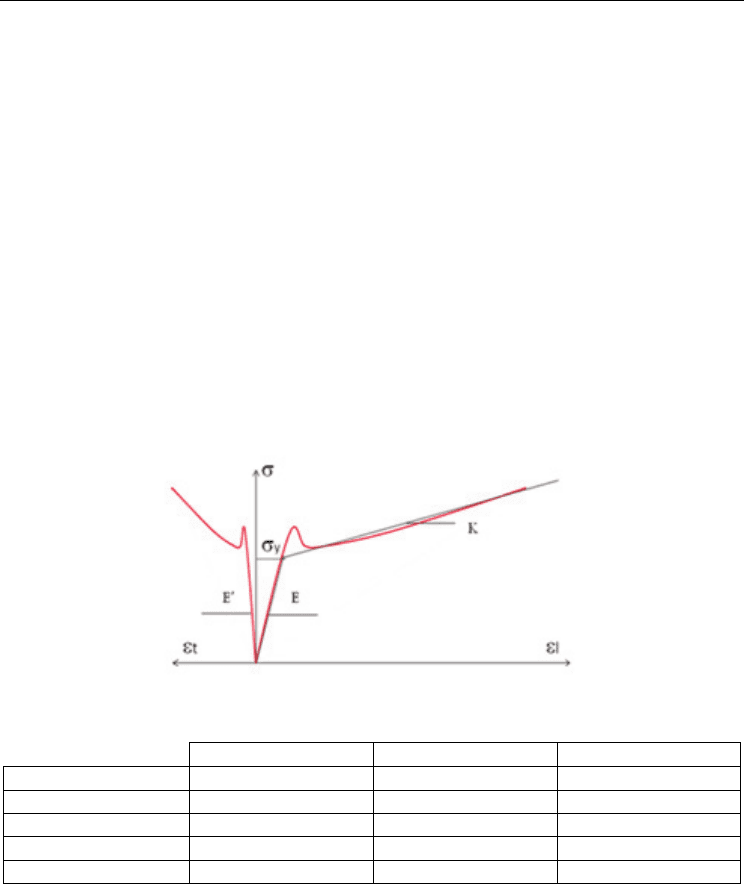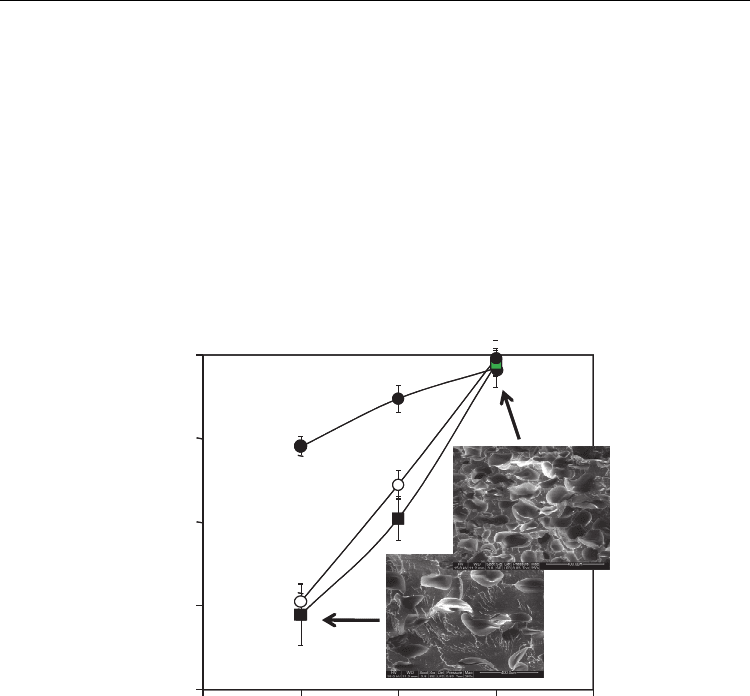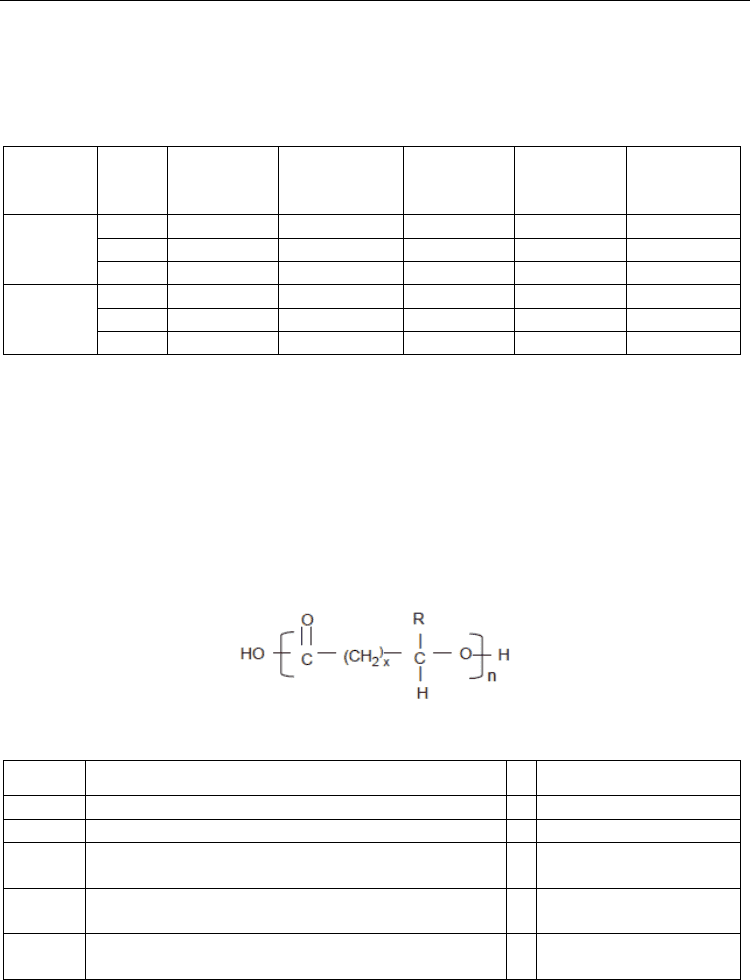Kumar E.S. (ed.) Integrated Waste Management. V.I
Подождите немного. Документ загружается.


Environmental-Friendly Biodegradable Polymers and Composites
351
polyhydroxyalkanoates (PHA) and (iii) from petrochemical products (conventional
synthesis from synthetic monomers) such as polycaprolactones (PCL) and aromatic and
aliphatic copolyesters. A wide range of these biodegradable polymers is now commercially
available, offering all sorts of properties that enable them to compete with non-
biodegradable polymers in several industrial sectors.
Fig. 7. Tensile strength as a function of elongation at break for various protein-based films
prepared under different conditions : plasticized by glycerol and processed at 90°C,
120°C, 140°C, 120°C containing shells and plasticized by triethanolamine and
processed at 120°C
4.1 Polylactic acid-based polymers
PLA is currently one of the most promising biopolymers. During the last decade PLA has
been the subject of an abundant literature, with several reviews and book chapters
(Averous, 2004; Garlotta, 2002; Auras et al, 2004; Mehta et al, 2005; Sodergard & Stolt, 2002).
Processable by many techniques (blowing films, injection moulded pieces, calendared and
thermoformed films…) a wide range of PLA grades is now commercially available with
companies such as Cargill (USA), Mitsui Chemical (Japan), Galactic (Belgium), Shimadzu Co
(Japan), Purac (Netherland) and many others (Shen et al, 2009).
After a general presentation of the synthesis and properties of polylactic acid, this chapter
will detail three case studies.
The first case study concerns a biocomposite for automobile applications combining a
PLA-based matrix and an alterable glass fibre. The challenge of the work is twofold:
maintaining constant mechanical properties under aggressive conditions (temperature,
moisture, mechanical stresses) during the in-service life of the automobile and having a
material that is easily recycled by composting at the end of its life.
The second study case concerns PLA-based films for some textile applications, especially
disposable safety workwear. With identical performances to non woven tissues or polyolefin
weldable films, PLA films are considered to be competitive alternatives because of their

Integrated Waste Management – Volume I
352
biodegradability. The required performances (tear resistance, weldability, perforation, thermal
resistance, barrier properties…) can be achieved by incorporating specific additives
(plasticizers, chain extender molecules, crosslinking agents…) and defined nanoparticles.
The third study case concerns PLA-based foam products. With the aim of reducing the
environmental impact of plastics, these materials are of major industrial interest, replacing
heavy items by lighter bio-based products with identical performance levels. They could be
considered as interesting alternative candidates to polyethylene foams, for example, with
expansion rates of about 50%. The objective of the studies concerned is to optimize either the
processing conditions (extrusion flow rate, temperature, cooling system) or the material
formulation (content of chemical blowing agent, PLA characteristics) for maximum foam
expansion and good mechanical performances.
Finally it is important to underline that PLA is considered as one of the three biodegradable
polymers used for clinical applications, together with polyglycolic acid (PGA) and
paradioxanone (PDS). Copolymers of PLA and PGA remain the most interesting alternatives
to metals for bone consolidation. These applications will not be detailed in this chapter.
4.1.1 Synthesis and properties of PLA
Lactic acid is extracted from starch and converted to a high molecular weight polymer
(Mw>100000) through an indirect polymerization route via lactide. This route was first
demonstrated by Carothers in 1932 (Carothers, 1932) but high molecular weights were not
obtained until improved purification techniques were developed (Garlotta, 2002). The
mechanism involved is ring-opening polymerization (ROP) and may be ionic or
coordination-insertion depending on the catalytic system used (Auras et al, 2004; Sodergard
& Stolt, 2002; Stridsberg et al, 2001; Mehta et al, 2005).
All properties of PLA depend on its molecular characteristics, as well as the presence of
ordered structures (crystalline thickness, crystallinity, spherulite size, morphology and
degree of chain orientation). The physical properties of polylactide are related to the
enantiomeric purity of the lactic acid stereo-copolymers. PLA can be produced totally
amorphous or up to 40 % crystalline. PLA resins containing more than 93 % of L-lactic acid
are semi-crystalline, while those containing 50–93 % are entirely amorphous. The typical
PLA glass transition temperature ranges from 50°C to 80°C, whereas the melting
temperature ranges from 130°C to 180°C. The mechanical properties of PLA can vary
considerably, ranging from soft elastic materials to stiff high strength materials, according to
various parameters, such as crystallinity, polymer structure, molecular weight, material
formulation (plasticizers, blend, composites…) and processing. For instance, commercial
PLLA (92% L-lactide) has a modulus of 2.1 GPa and an elongation at break of 9 %. The CO
2
permeability coefficients for PLA polymers are lower than those reported for crystalline
polystyrene at 25°C and 0 % of relative humidity and higher than those for PET. The main
abiotic degradation phenomena of PLA involve thermal and hydrolysis degradations.
4.1.2 Polylactic acid-based biocomposites for automobile applications
It is well known that the development of automobile parts requires materials with high
mechanical characteristics and good thermal properties that remain constant throughout the
in-service life of the automobile in a potential aggressive environment. This challenge could
be achieved by the incorporation of reinforcements. Natural fibres are commonly used to
reinforce PLA because of their renewability and biodegradability. Moreover, their low price

Environmental-Friendly Biodegradable Polymers and Composites
353
and low density are complementary advantages. Unfortunately, their main drawbacks are
their relative low mechanical properties depending on the production location and crop, the
weakness of the matrix/fibre interface and the potential competition with food production.
Our research centre and OCV Chambéry International (Chambéry, France) joined forces to
develop an innovative biodegradable biocomposite reinforced by glass fibres that can be
degraded by water and mineralized by microorganisms without any toxic components being
released into the environment. This alterability, combined with the good reproducibility of
glass fibre properties compared to plant fibres, shows considerable promise. This research
program was supported by the French organizations ADEME and ANR.
4.1.2.1 Alterable glass fibres
Most of the alterable glasses developed in recent years have been used in medical
applications. They are based on silicate, calcium and phosphate components, leading to an
improvement in micro-organism activity. They are incorporated within several
biodegradable polymers such as PLA (Zhang et al, 2004) allowing bone reconstruction.
Several steps are involved in glass alteration: inter-diffusion (exchanges between alkaline
components of the glass and the solution), glass hydrolysis (direct interaction with intrinsic
glass network), gel formation (re-condensation of some components such as silicates),
precipitation of secondary phases. Several parameters may influence these mechanisms,
such as glass composition, pH, temperature, contact surface and micro-organisms. For this
project the main alterable glass formulations were based on silicate and moreover present
the advantage of having a lower melting temperature and therefore lower energy
requirements for processing than conventional glasses.
4.1.2.2 Mechanical properties of biocomposites
An alterable glass fibre (AGF) and a conventional E-glass fibre (E) were compared, both
coated with a standard water based sizing used in traditional polyester composites (such as
PET or PBT). A comparison with hemp natural fibre (HNF) will be also carried out. Classical
co-rotating extrusion (Clextral BC21) and injection molding (Sandretto) processes were used
for the elaboration of PLA (PLA 7000D© provided by Nature Works LCC, USA) reinforced
by 30 wt% of fibres.
PLA PLA/E PLA/AGF PLA/HNF
Bending
Modulus (GPa)
3.36 0.02 10.15 0.25 9.28 0.09 5.78 0.09
Strength (MPa)
102 1 171 5 138 4 102 2
Elongation (%)
3.5 0.0 1.8 0.1 1.6 0.1 2.4 0.2
Tensile
Modulus (GPa)
3.61 0.07 10.48 0.28 9.81 0.08 5.89 0.12
Strength (MPa)
72 1 122 2 116 6 73 1
Elongation (%)
7.5 1.2 3.3 0.1 3.4 0.3 3.0 0.1
Impact Resilience (kJ/m
2
)
30 5 29 2 32 2 14 2
Table 7. Mechanical properties of PLA and PLA composites reinforced by a conventional E-
glass fibres (PLA/E), alterable glass fibres (PLA/AGF) and hemp natural fibres (PLA/HNF)
(30 wt%)
The mechanical data are summarized on Table 7. The results show that the presence of
hemp natural fibres within the PLA slightly increased the tensile and bending moduli but
did not improve other mechanical properties (strength and elongation). Moreover a lower
resilience was obtained for the HNF reinforced biocomposites compared to unreinforced

Integrated Waste Management – Volume I
354
PLA. The presence of glass-based fibres led to a significant increase in bending and tensile
moduli and strengths and a decrease in corresponding elongations. The impact properties
were not influenced by the presence of glass-based fibres. However, AGF-fibres result in
lower mechanical properties than E-fibres.
4.1.2.3 Ageing resistance of biocomposites
One of the scientific problems is to be able to maintain consistent properties throughout the
in-service use of the biocomposites, while also being able to trigger their ultimate
biodegradation/composting at the end of their life, as shown in Figure 8.
Fig. 8. Control of ageing and biodegradation kinetics of materials
It is well known that the main degradation mechanism of PLA is hydrolysis, which
increases markedly above Tg and with ageing time due to the formation of hydrophilic
groups such as alcohols and acid functions (Li & McCarthy, 1997). In addition, crystallinity
and the presence of microvoids or porosity may affect water permeation (Drumright et al,
2000). Several ageing tests have been developed to analyze the evolution of material
properties, among them accelerated ageing tests. For the present study biocomposites were
conditioned within an autoclave with 100 RH% and at 65°C (above Tg), simulating several
years of in-service use. Figure 9 shows the evolution of mechanical properties together with
water absorption and crystallinity rate against ageing time. A significant decrease can be
observed for all mechanical properties, with the lowest decrease being obtained for PLA/E
biocomposites and the highest for PLA/AGF ones. With regard to water absorption, the
presence of E-glass fibres may decrease the water content (0.61% compared to 1.37% for
PLA) whereas the alterable fibres did not change the water content. A huge absorption rate
was observed for HNF reinforced biocomposites (4.35%) due to the intrinsic hydrophilic
character of these fibres. Whatever the biocomposite, an increase in crystallinity rate can be
observed at short ageing time (+20% after an ageing time of 24h), then a plateau is obtained
except for HNF reinforced PLA.
4.1.2.4 Biodegradation of biocomposites
Different degradation tests were performed on the PLA and biocomposites.
One of them was the previously described BOD test (see § 3.1.2.2.4), which showed no
influence of the presence of alterable glass fibres (AGF) either on the latency time (about 10
days) or on the final degradation rate after 28 days (about 15 %) of PLA.

Environmental-Friendly Biodegradable Polymers and Composites
355
0
20
40
60
80
100
120
140
0 50 100 150 200 250
ageing time (h)
strength
(MPa)
(a)
0
1
2
3
4
5
6
0 50 100 150 200 250
ageing time (h)
elonggation
(%)
(b)
0
5
10
15
20
25
30
35
0 50 100 150 200 250
ageing time (h)
impact strength
(kJ/m2)
(c)
0
1
2
3
4
5
0 50 100 150 200 250
ageing time (h)
absorption rate (%)
(d)
0
10
20
30
40
50
60
0 50 100 150 200 250
ageing time (h)
crystallinity
(%)
(e)
Fig. 9. Variation of (a) ultimate strain, (b) ultimate stress, (c) impact strength, (d) water
absorption rate and (e) crystallinity rate of () PLA and PLA composites reinforced by by
(O) conventional E-glass fibres (PLA/E), () alterable glass fibres (PLA/AGF) and ()
hemp natural fibres (PLA/HNF) (30 wt%) with ageing time (65°C; 100 %RH)

Integrated Waste Management – Volume I
356
Another test was performed according to XPU 44-163 standards and gave the mineralisation
rate of PLA and biocomposites (Figure 10). It was observed that mineralisation rate of PLA
does not stop increasing with a value of 170 mg CO
2
/g of PLA after 49 days with a final pH
of the soil of 4.24. In the case of the biocomposites, a decrease in this mineralisation rate can
be observed with various behaviours according to the fibre nature. In presence of AGF a
plateau is reached after 25 days (120 mg CO
2
/g of composite) and acidification of the soil is
observed (final pH at 4.06) which may induce a decrease in microbial activity. The lowest
mineralisation rate, together with acidification of the soil (final pH at 3.91,) was obtained in
the presence of HNF (60 mg CO
2
/g of composite).
One purpose of this study was to propose glass formulation that may buffer the soil to avoid
acidification and therefore the decrease in microbial activity.
0
50
100
150
200
0 1020304050
days
mg CO2/g C composite
4.06
3.91
4.24
Fig. 10. Mineralisation rate and final pH of the soil for () PLA and PLA composites
reinforced by () alterable glass fibres (PLA/AGF) and () hemp natural fibres (PLA/HNF)
(30 wt%)
4.1.2.5 Further studies
Current studies are focussing on improving both the glass formulation and the PLA-based
matrix properties. Concerning the glass, new glass compositions are being developed to
control either the mechanical properties of the alterable fibre in order to be comparable to
conventional E-glass fibres (with a Young’s modulus about 73 GPa) or the alteration
mechanism. For the PLA-based matrix, investigations are being carried out to increase
impact properties as well as durability by incorporating impact modifiers and/or blending
with other biodegradable polymers that are more ductile and less hydrophilic than PLA.
4.1.3 Polylactic acid-based films for textile applications
This second case study concerns PLA-based films for some textile applications, especially
disposable safety workwear. The required performances (among them tear resistance,

Environmental-Friendly Biodegradable Polymers and Composites
357
weldability, perforation, thermal resistance, barrier properties) were achieved by
incorporating nanoclays and specific additives.
Various mechanical behaviours were obtained according to the nature of the nanoparticles
and their surface modifications. A fibrillar sepiolite and a lamellar montmorillonite (called
MMT) were compared for a content of 2.5 wt%. They were respectively treated with a silane
coupling agent (-methacryloxy-propyltriethoxysilane) and a quaternary ammonium salt.
PLA (PLA4032D© provided by Nature Works LCC, USA) was plasticized (18 wt% of
tributylacetylacetate from Sigma Aldrich). A chain extender (styrene-co-glycidyl
methacrylate, trademarked Joncryl 4368© from BASF) was also added. A three-step process
was involved including (i) twin screw extrusion to obtain a PLA/clay masterbatch (85/15
w/w), (ii) dilution and addition of plasticizer and chain extender through twin screw
extrusion and (iii) blowing extrusion to obtain 50µm thick films.
The first analysis of the behaviour was performed using the tensile tests performed for each
formulation. These tests were carried out using an optical extensometer combining a Charge
Couple Device (CCD) camera associated with Digital Image Correlation (DIC) software.
This revealed the evolution of the in-plane strains (transverse and longitudinal components)
(Figure 11). Table 8 summarizes all mechanical characteristics. While it can be observed that
a lower yielding stress was obtained for PLA films filled with sepiolite clay, on the other
hand they showed higher work hardening (K).
Fig. 11. Evolution of the in-plane strains (transverse and longitudinal components)
E (MPa)
y (MPa)
K
PLA 1100 (10) 26 (11) 1 (8)
PLA/sepiolite 390 (10) 16 (8) 17 (3)
PLA/mod-sepiolite 600 (14) 15 (7) 17 (3)
PLA/MMT 700 (10) 21 (4) 12 (5)
PLA/mod-MMT 1100 (10) 27 (2) 13 (5)
Table 8. Longitudinal mechanical characteristics obtained from loading curves of stress vs
deformation (100 mm/min, sample 150x50x100 mm
3
) for PLA and PLA composites
reinforced by unmodified and modified (mod) sepiolite and montmorillonite – (): variance
4.1.4 Polylactic acid-based foam products
Obtaining PLA-based foam products is of major industrial interest, in order to replace high-
mass products by lighter bio-based ones with identical performances. They can be
considered as interesting alternative candidates.

Integrated Waste Management – Volume I
358
The objective of the studies concerned was to optimize either the processing conditions
(extrusion flow rate, temperature, cooling system) or the material formulation (content of
chemical blowing agent, PLA characteristics) for maximum foam expansion and good
mechanical performances.
Results show that the nature of the PLA (PLA 7000D© and PLA4032D© provided by Nature
Works LCC, USA) had no major effect on the void content of the foams extruded under the
same conditions (screw range temperature: 150-180°C) (Figure 12). The density varied
between 893 and 879 kg/m
3
for a CBA content of 2 wt% (corresponding to a density
reduction of 29 % and 30 %, respectively). Moreover, the void content increased gradually
(the foam density decreased) with the CBA content, regardless of the PLA type or
temperature profile. This evolution is related to the amount of gas formed and available for
the expansion process (Klempner & Sendijarevic, 1991). Similar results have been reported
for extruded foams based on polyolefins (Lee, C.H. et al, 2000; Lee, S.T., 2004, 2008).
25
30
35
40
45
12345
void fraction V
f
(%)
25
30
35
40
45
12345
CBA (wt%)
void fraction V
f
(%)
Fig. 12. Void fraction of PLA foams as a function of the chemical blowing agent content
(CBA), the processing conditions (screw range temperature : 130-190°C; , 150-180°C)
and the PLA nature ( PLA4032D©, , PLA7000D©) and corresponding microstructures
(ESEM observations; magnitude 250X)
In addition, both PLAs investigated provided foams with homogeneous cellular structures
(polydispersity PDI close to 1) (Table 9). In all cases, the open-cell ratio was low, below 26 %.
Similar results have been reported for polyolefin foams (Klempner & Sendijarevic, 1991; Ray
& Okamoto, 2003; Ema et al, 2006). An increase in the open-cell ratio with the CBA content is
observed which is related to the amount of gas release. This trend has already been reported
by other authors (Klempner & Sendijarevic, 1991; Lee, C.H. et al, 2000). A higher open-cell
ratio range is obtained for PLA4032D© (ratio between 19 and 27% for CBA content between
2 and 4 wt%) compared to PLA7000D© (ratio between 11 and 19%). This is related to the
higher temperatures involved in the temperature profile used for PLA4032D© inducing a

Environmental-Friendly Biodegradable Polymers and Composites
359
higher gas yielding as well as a lower PLA viscosity The cell density of the PLA7000D©-
based foams processed with a screw temperature range 130-190°C was significantly higher
than that of PLA4032D©-based foams processed with the screw temperature range 150-
180°C. This is undoubtedly related to gas loss through the first barrel zones during
extrusion-foaming of the PLA4032D©. Moreover, for PLA7000D©, the cell density decreases
with the CBA content as the cell size increases with no variation in the cell wall thickness.
For PLA4032©, a slight increase in cell density is observed with a non monotonous variation
in cell size and a significant decrease in the cell wall thickness. It can be assumed that
several competitive mechanisms may occur: (i) the increase in gas yielding and decrease in
viscosity due to barrel temperatures, (ii) the plasticization induced by the gas products
during decomposition and (iii) the presence of a higher content of nucleating agents present
in the CBA masterbatch. Complementary work is in progress to evaluate the relative
contributions of these mechanisms. The average cell diameter and cell-wall thickness in the
present study were similar to those reported for polyolefin foamed with CBA (Klempner &
Sendijarevic, 1991; Lee, C.H. et al, 2000), but significantly higher than those reported by
other authors for microcellular PLA foams (Ray & Okamoto, 2003). Nevertheless, the cases
reported in the literature concern mainly physical foaming processes, and PLA modified by
nanofillers (which may act as cell nucleating agents) and/or chain extenders.
Finally, for both types of PLA investigated, the increase in CBA content led to a reduction in
stresses at yield and break in tension (Table 10), due to the increase in void content
(reduction of the effective sample cross-section). On the contrary, elongation at yield and
break were low and independent of the CBA content. Similar results were reported for PVC
and PUR-based foams (Kabir et al, 2006; Lin, 1997).
PLA
CBA1
(%wt)
d
n
(µm)
d
w
(µm)
PDI
N
c
(cells.cm
-3
)
10
5
(µm)
C
o
(%)
7000
D©
2 90 (2)
105
(1)
0.86
(0.01)
11.25 (0.78) 48 (1) 10.91 (0.24)
3 95 (2)
104
(1)
0.91
(0.01)
10.13 (0.70) 46 (1) 14.72 (1.08)
4
107
(2)
122
(2)
0.88
(0.01)
7.38 (0.51) 49 (1) 19.22 (0.69)
4032
D©
2
134
(3)
144
(2)
0.93
(0.01)
2.72 (0.19) 95 (2) 19.12 (1.47)
3
125
(3)
174
(2)
0.72
(0.01)
4.02 (0.28) 71 (2) 24.49 (1.3)
4
130
(3)
152
(2)
0.86
(0.01)
4.19 (0.29) 58 (1) 26.76 (1.11)
Table 9. Cell dimensions (d
n
, d
w
), cell density (N
c
), cell size polydispersity (PDI), cell-wall
thickness () and open-cell ratio (C
o
) as function of CBA content – PLA 7000D© screw
temperature range 130-190°C and PLA 4032D© screw temperature range 150-180°C; screw
speed 30 tr/min; die temperature 195 °C; free cooling - ( ) : standard deviation
4.2 Polyhydroxyalkanoates
Like polylactic acids, polyhydroxyalkanoates (PHAs) are aliphatic polyesters (Figure 13)
produced via fermentation of renewable feedstock. Whereas PLA production is a two-stage

Integrated Waste Management – Volume I
360
process (fermentation to monomer followed by a conventional polymerization step), PHAs
are produced directly via fermentation of carbon substrate within the microorganism. The
PHA accumulates as granules within the cytoplasm of cells and serves as a microbial energy
reserve material. PHAs have a semicrystalline structure, the degree of crystallinity ranging
from about 40% to around 80% (Averous, 2004).
PLA
CBA
(wt%)
Void
fraction
(%)
max
(MPa)
max
(%)
r
(MPa)
r
(%)
7000D©
2 42 (1) 36.00 (2.84) 8.41 (0.32) 33.38 (2.18) 9.95 (0.71)
3 45 (1) 25.65 (1.33) 8.84 (0.39) 21.51 (1.72) 11.59 (0.92)
4 47 (1) 23.71 (0.90) 8.37 (0.55) 20.49 (1.08) 10.28 (1.16)
4032D©
2 34 (1) 40.54 (3.27) 10.24 (0.89) 37.91 (3.90) 11.51 (1.23)
3 41 (1) 30.68 (2.40) 8.61 (0.70) 27.14 (3.44) 10.43 (1.11)
4 48 (1) 26.77 (1.24) 9.44 (1.36) 22.87 (1.12) 11.50 (1.60)
Table 10. PLA-foams tensile properties. Processing conditions: PLA 7000D© screw
temperature range 130-190°C and PLA 4032D© screw temperature range 150-180°C; screw
speed 30 tr/min; die temperature 195 °C; free cooling. (
max
: yield stress,
max
: elongation at
yield stress,
r :
stress at break,
r
: elongation at break) - ( ) : standard deviation
Table 11 shows the generic formula for PHA where x is 1 (for all commercially – relevant
polymers) and R can be either hydrogen or hydrocarbon chains of up to around C16 in
length. A wide range of PHA homopolymers, copolymers and terpolymers have been
produced, in most cases at the laboratory scale. A few of them have attracted industrial
interest and been commercialized in the past decade.
Fig. 13. PHA molecule
PHA full name x R
PHB Poly(3-hydroxybutyrate) P(3HB) 1 -CH
3
PHV Poly(3-hydroxyvalerate) P(3HV) 1 -CH
2
CH
3
PHBV Poly(3-hydroxy butyrate-co-valerate) P(3HB-co-
3HV)
1 -CH
3
and –CH
2
CH
3
PHBHx Poly(3-hydroxy butyrate-co-hexanoate) P(3HB-co-
3HHx)
1 -CH
3
and –CH
2
CH
2
CH
3
PHBO Poly(3-hydroxy butyrate-co-octanoate) P(3HB-co-
3HO)
1 -CH
3
and –(CH
2
)
4
CH
3
Table 11. Examples of structures of PHA
Like PLA, PHA is sensitive to processing conditions. Under extrusion, a rapid decrease in
viscosity and molecular weight can be observed due to macromolecular linkage by
